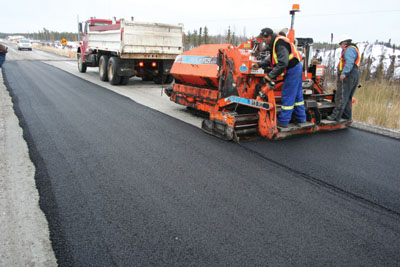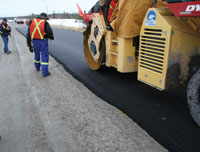
Features
Roads & Paving
Technology
EZ does it
This cold asphalt material could be a game-changing product.
December 3, 2010 By Rob Blackstien
As its moniker suggests, EZ Street can make life a breeze for
roadbuilding and repair crews. The name also accurately defines why the
product is already being used in 20 countries and is quickly gaining
traction in Canada since the launch of EZ Street Canada three years ago
in Yellowknife.
As its moniker suggests, EZ Street can make life a breeze for roadbuilding and repair crews. The name also accurately defines why the product is already being used in 20 countries and is quickly gaining traction in Canada since the launch of EZ Street Canada three years ago in Yellowknife.
To date, EZ Street’s sweet spot here in the Great White North has been as a maintenance product, but an October 2009 full-width surfacing project in Yellowknife could pave the way for larger applications of this innovative technology.
 |
| EZ Street being applied on a project near Yellowknife, N.W.T., in a full-width surfacing project. The product can extend the roadbuilding season extensively in cold climates. (Photo courtesy of EZ Street) Advertisement
|
“We found out about the polymer and all its amazing attributes and thought ‘what better place to test it out than here in Yellowknife in the north?’” says Chris Hunt, one of four founding partners of EZ Street Canada and a member of the management team of Yellowknife-based Nuna Innovations. Nuna Innovations is the management division of Nuna Logistics, a builder of mines and mine roads that purchased a 50% interest in EZ Street Canada last year and now oversees the company.
The attributes that Hunt refers to include EZ Street’s ability to be applied at ambient temperatures to permanently repair potholes, utility cuts, overlays and edge repairs in asphalt or concrete. It can be stockpiled for months, and it can be applied in temperatures ranging from -18 to 38 C regardless of the weather conditions (for more about EZ Street’s advantages, please see sidebar – Using EZ Street).
Producing EZ Street
The product can be produced in any asphalt plant without the need for special outfitting. In fact, it’s made exactly the same way hot mix is produced, except for one tiny, but crucial difference – the polymer additive.
Traditional hot mix includes 4 to 6% liquid content, and with EZ Street, approximately 3% of that liquid component is polymer (i.e., 0.0012% to 0.0018% of the entire mix). “It’s a very small amount, but it does an amazing amount of work,” Hunt explains.

|
|
| A crew compacts EZ Street on a 32-foot-wide section of Highway 3 near Yellowknife, N.W.T. EZ Street can be applied in temperatures as low as -18 C. (Photo courtesy of EZ Street)
|
The difference for roadbuilders is immense, as not only can the product be applied cold, but it doesn’t even matter if it’s raining while you’re laying it down, something that would be impossible to do with a hot-mix project. “It’s like putting a Gortex jacket on asphalt and suddenly it becomes weatherproof,” Hunt explains. “You can install EZ Street in a torrential downpour, in a hurricane basically.”
This results in massive logistical advantages, as with hot-mix asphalt, you have to apply the mix shortly after the product has been made, and once it is installed, you only have a short window of time to compact, so if there’s a delay caused by weather or equipment not arriving on time and that asphalt cools before it’s compacted, it becomes landfill bound.
“Logistically, it’s a real game changer because it kind of separates the traditional installation and production connection that you have with hot mix,” Hunt explains.
| Uncle Sam approved
One of EZ Street’s big name customers is the U.S. army, which has employed the product for patches on runways at Andrews Air Force Base as well other classified locations. The fact that the air force employs this product on runways that support $25 million fighter jets speaks volumes, but the army did its due diligence on the product. A report created by the U.S. Army Corps of Engineers stated that EZ Street was graded the highest in terms of stability of the nine products that were evaluated as expedient repair materials for roadway pavements. |
In the Field
Weather issues and a small window in which to complete scheduled paving projects are challenges that David Krutko understands. The Northwest Territories member of the legislative assembly, Mackenzie Delta, explains that this summer the N.W.T. Department of Transportation planned to pave 70 kilometres of Highway 1, but weather conditions dictated otherwise, and only 25 kilometres were completed. “They couldn’t apply it because of the amount of rain and precipitation we had over the summer months,” Krutko says.
In Yellowknife, the construction season is just six to eight weeks long; any further eroding of that time frame makes it impossible to finish the allotted work. Until now, that is.
While EZ Street has been in use for three years as a maintenance product by both the city of Yellowknife and the Territorial government – as well by as several other cities across the country – the full-width surfacing project performed last October on Highway 3 could be the start of the something big.
Like most politicians, Krutko is interested in the bottom line. EZ Street is about 20% more expensive than traditional hot mix, but the logistical savings – no waste, no ruined product, the ability to stockpile it – make sense to him. Previously, the GNWT Transportation Department had been using chip seal to repair roads.
“Basically, the life of the product is good for somewhere between five and seven years,” Krutko says of chip seal. “What we were finding was you have to invest a million dollars and replace it every five to seven years.”
Because of the short life span of chip seal, it made economic sense to look at other products, and with its guarantee to be a permanent fix, EZ Street fills the bill. The fact that it can be applied in colder temperatures – thereby extending the paving season – makes a lot of sense both logistically and economically, Krutko explains.
He adds that they are interested in using this product in the northern part of the territory, “which can have an even shorter construction season than we have down here,” he says, referring to Yellowknife’s geographic co-ordinates being in the southern part of the territory.
The Yellowknife surfacing project consisted of paving 100 metres of a 32-foot-wide highway, located about 20 kilometres west of the city. Completed in an afternoon, the surface was prepared with a grader tight blade run over the frozen gravel. Then, the crew marked for the mat runs. The material was loaded at ambient temperature (- 6 C) from a nearby outdoor stockpile, and then the surfacing was begun using a traditional paver with no heat applied.
Each mat was two inches deep loose, and then was compacted down to 1.5 inches using a steel roller, and even at that temperature, the material was seamless upon compaction. As soon as the product was installed and compacted, they did a test run over the surface.
“We do believe that that was probably a bit historic,” Hunt says of the project. “I don’t think anybody’s ever done what we did at that time of year.”
Lars Seagren, who founded Miami-based The EZ Street Company with his brother Dag, understands the significance of this project, but he’s doing his best to keep his emotions in check, saying they “are cautiously optimistic” about what the Yellowknife project could spark. “We’re not jumping up and down yet,” he says while adding that maybe they would like to – just a little.
Rob Blackstien is a freelance writer and the principal of Pen-Ultimate, a Toronto, Ont.-based writing and editorial services firm.
| Using EZ Street
EZ Street is “definitely a transformative type of technology,” Chris Hunt of Nuna Innovations says. Here are a few reasons why:
EZ Street is currently being produced in 12 plants across the country in almost every province and territory. The company partners up with traditional hot-mix producers, road maintainers and larger contractors, providing the polymer and ensuring quality control of the product. “We attend every production,” Hunt says. “It’s a brand, so we want to make sure worldwide that that brand is always protected. Quality is paramount.” The mix design is not standard; it’s customized in each instance, Hunt explains. “We’ll look at your location, your climate, what type of application it’s going to be used for, like if it was going to be used for a surfacing job, then we’d use different size of aggregates and things like that,” Hunt says. “So it’s very customized, which is all part of the quality of it as well.” |
Print this page